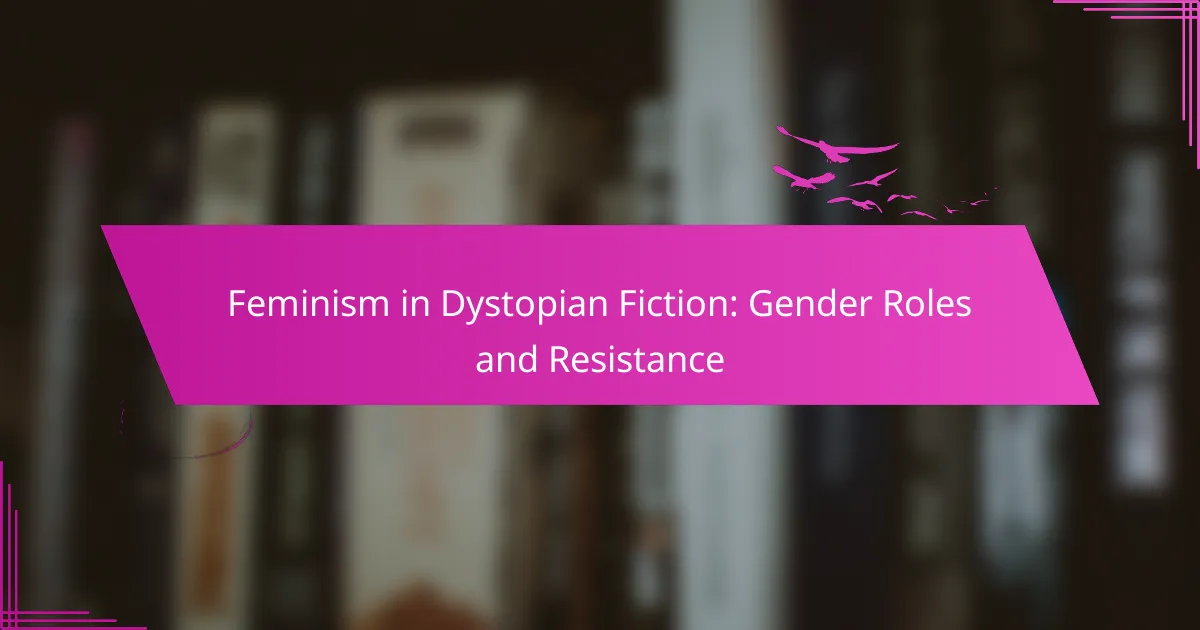Feminism in dystopian fiction challenges oppressive gender roles and highlights acts of resistance. This article explores how female characters confront patriarchal norms, the portrayal of solidarity and activism, and the diverse strategies of empowerment in various cultural contexts. It also examines the relevance of these narratives in contemporary discussions about gender equality and societal norms.
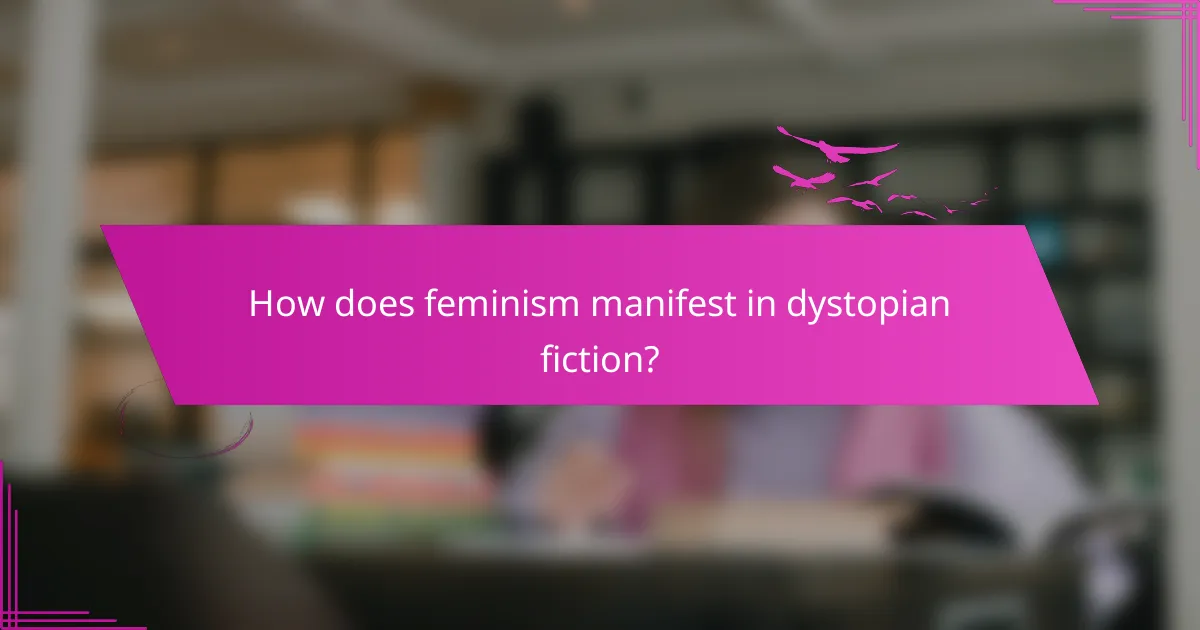
How does feminism manifest in dystopian fiction?
Feminism in dystopian fiction often manifests through the exploration of gender roles and acts of resistance against oppressive systems. Characters challenge patriarchal norms, highlighting women’s strength and resilience. For example, novels like “The Handmaid’s Tale” depict women’s struggles for autonomy and identity in oppressive societies. These narratives often reflect real-world gender inequalities, making feminism a critical lens for analyzing dystopian themes. The unique attribute of these works lies in their portrayal of female solidarity and activism, which inspires readers to reflect on contemporary issues.
What are the key themes of gender roles in dystopian narratives?
Feminism in dystopian fiction often explores themes of gender roles and resistance against oppressive systems. Key themes include the subversion of traditional gender roles, the portrayal of female empowerment, and the critique of patriarchal structures. Dystopian narratives frequently depict women as central figures in resistance movements, challenging societal norms. Additionally, these stories highlight the consequences of extreme gender inequality, showcasing the struggle for autonomy and rights. The exploration of intersectionality within gender roles adds depth, revealing how race, class, and sexuality intersect with women’s experiences in oppressive societies.
How do female protagonists challenge societal norms?
Female protagonists challenge societal norms by embodying resistance against traditional gender roles. They often defy expectations, showcasing strength and autonomy. Dystopian fiction highlights their struggles, revealing societal flaws and inspiring change. These characters serve as catalysts for discussions on gender equality, pushing boundaries and redefining femininity. Through their journeys, they encourage readers to question established norms and envision alternative futures.
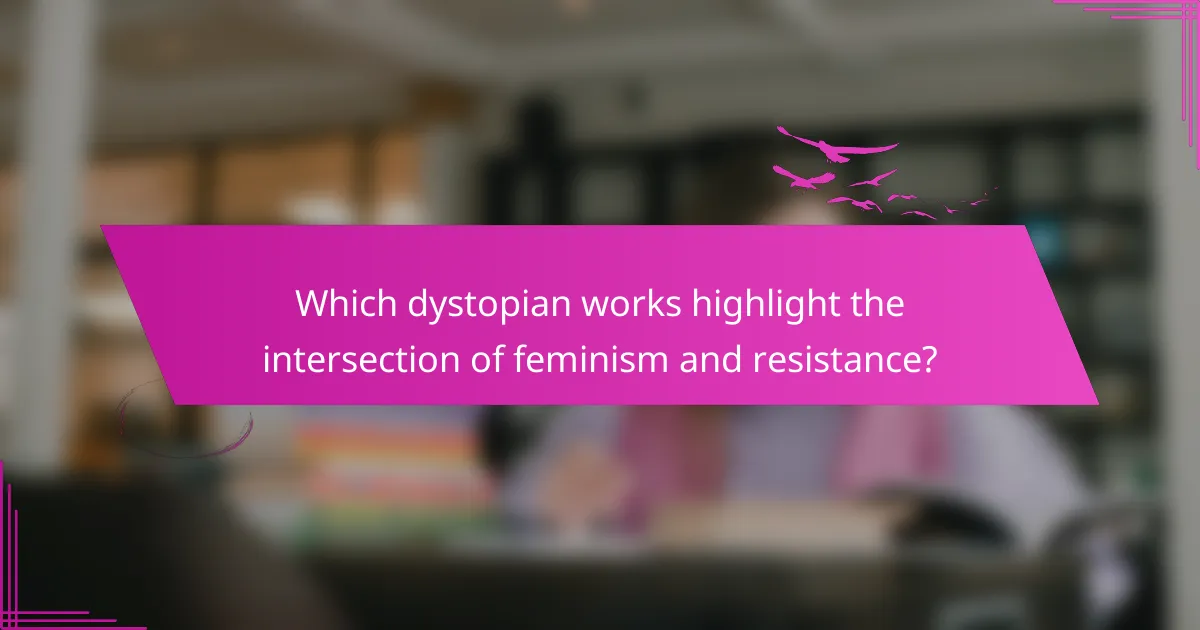
Which dystopian works highlight the intersection of feminism and resistance?
Several dystopian works explore feminism and resistance, emphasizing women’s roles in challenging oppressive systems. Notable examples include “The Handmaid’s Tale” by Margaret Atwood, which portrays a theocratic regime subjugating women, and “Parable of the Sower” by Octavia Butler, highlighting female resilience in a collapsing society. Additionally, “The Power” by Naomi Alderman examines gender dynamics through a speculative lens, where women gain physical dominance. These narratives underscore the intersection of feminism and resistance, showcasing women’s struggles against patriarchal structures.
What role do classic dystopian novels play in feminist discourse?
Classic dystopian novels play a significant role in feminist discourse by challenging traditional gender roles and highlighting resistance against patriarchal structures. These narratives often depict societies where women face oppression, enabling critical analysis of gender dynamics.
For example, in “The Handmaid’s Tale,” Margaret Atwood illustrates a future where women’s rights are stripped away, prompting discussions about bodily autonomy and control. Similarly, “Parable of the Sower” by Octavia Butler presents a female protagonist who embodies resilience and leadership, redefining gender expectations.
These novels serve as cautionary tales, urging readers to confront ongoing gender inequalities. By reflecting societal fears, they empower feminist movements to advocate for change and promote gender equality.
How do contemporary authors reshape feminist narratives in dystopian settings?
Contemporary authors reshape feminist narratives in dystopian settings by challenging traditional gender roles and highlighting resistance. They create complex female characters who navigate oppressive systems, often subverting patriarchal norms. For instance, in works like “The Power” by Naomi Alderman, women gain physical dominance, flipping societal expectations. This unique attribute of empowered femininity contrasts with historical portrayals of women as passive victims. Additionally, authors use dystopian backdrops to explore themes of autonomy, solidarity, and rebellion, reflecting real-world gender struggles. Such narratives resonate with readers, fostering discussions on feminism and societal change.
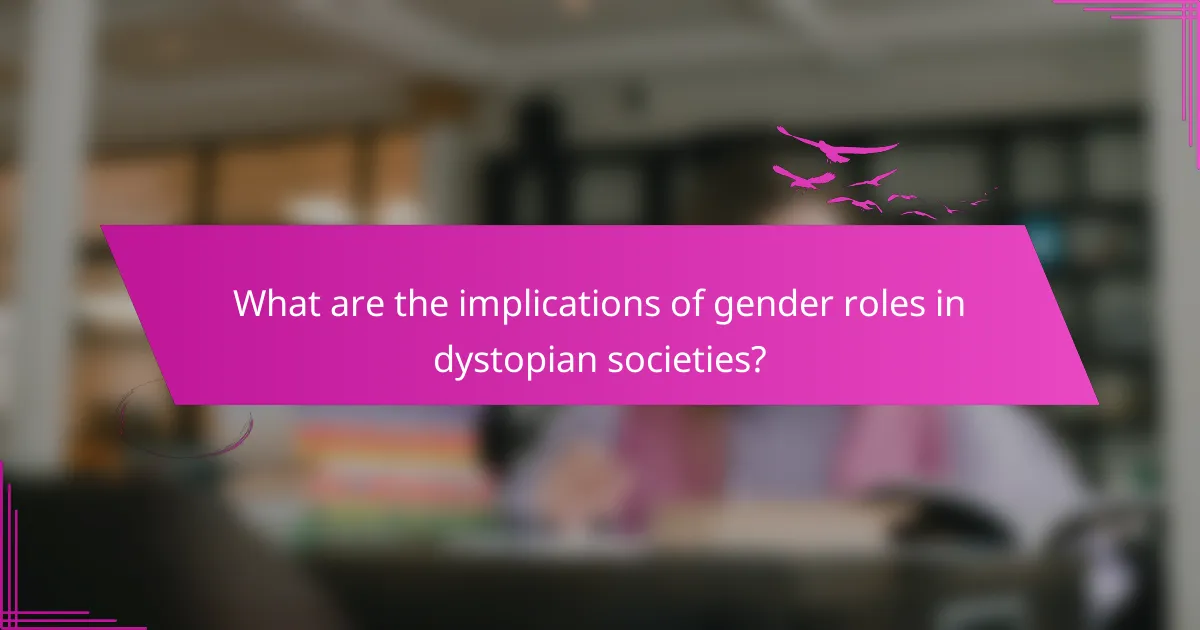
What are the implications of gender roles in dystopian societies?
Gender roles in dystopian societies often reinforce oppressive structures, limiting individual freedom. These narratives illustrate how traditional gender expectations can lead to resistance and empowerment. For example, in “The Handmaid’s Tale,” women are subjugated through strict roles, prompting acts of rebellion. Such portrayals highlight the complexities of gender dynamics, emphasizing the potential for female agency in oppressive contexts. The exploration of these themes in dystopian fiction fosters critical discussions about gender equality and societal norms.
How do oppressive regimes enforce traditional gender roles?
Oppressive regimes enforce traditional gender roles through strict societal norms, legal restrictions, and propaganda. These mechanisms aim to maintain control and suppress dissent.
For example, in dystopian fiction, regimes often depict women as subservient through laws that limit their autonomy. This reflects a unique attribute of these narratives, showcasing how power structures manipulate gender to reinforce hierarchy.
Additionally, resistance to these roles emerges in various forms, including underground movements and acts of defiance. These actions highlight the rare instances where characters challenge imposed norms, emphasizing the struggle for equality.
Such portrayals in literature resonate with real-world issues, illustrating the ongoing fight against gender oppression in contemporary societies.
What are the consequences of gender inequality in dystopian worlds?
Gender inequality in dystopian worlds leads to oppression, limited rights, and societal fragmentation. Women often face systemic violence, reduced autonomy, and restricted access to resources. As a result, resistance movements emerge, highlighting the struggle for equality and justice. Dystopian narratives illustrate the consequences of gender roles, emphasizing the need for solidarity and empowerment. These stories serve as cautionary tales, urging societies to confront gender disparities before they escalate into dire consequences.
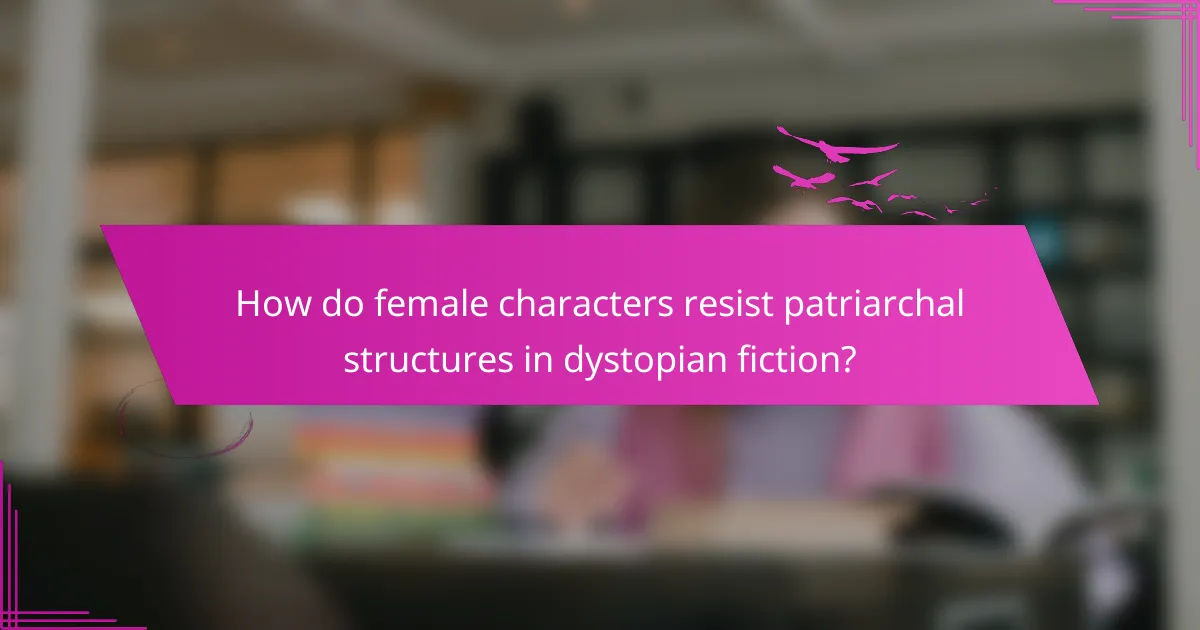
How do female characters resist patriarchal structures in dystopian fiction?
Female characters in dystopian fiction often resist patriarchal structures through rebellion, solidarity, and empowerment. They challenge oppressive norms by forming alliances, asserting their identities, and subverting traditional gender roles.
For example, in “The Handmaid’s Tale,” Offred’s internal resistance and connection with other women highlight the power of shared experiences. In “The Power,” women gain physical strength, flipping the power dynamics. These narratives illustrate the diverse strategies female characters employ to reclaim agency in oppressive environments.
Such resistance not only critiques patriarchal systems but also inspires readers to envision alternative futures. These stories emphasize the importance of women’s voices in shaping societies, showcasing resilience as a fundamental attribute of female characters in dystopian settings.
What strategies do women use to assert their agency?
Women in dystopian fiction assert their agency through defiance, collaboration, and strategic adaptation. They often resist oppressive systems by forming alliances, sharing knowledge, and utilizing their unique strengths. For instance, characters may leverage their resourcefulness to survive in harsh environments, showcasing resilience.
Additionally, narratives often depict women reclaiming power by challenging traditional gender roles. These portrayals highlight the importance of solidarity among women, emphasizing collective action against patriarchal structures. By navigating societal constraints, they embody resistance and inspire change.
In many stories, women also employ subversive tactics, such as espionage or sabotage, to undermine oppressive regimes. This strategic approach not only affirms their agency but also serves as a critique of power dynamics, illustrating the complexity of their struggles.
How does solidarity among women manifest in resistance movements?
Solidarity among women in resistance movements manifests through collective action, shared experiences, and mutual support. Women often unite to challenge oppressive systems, creating networks that amplify their voices. This collaboration fosters resilience and empowers individuals, leading to significant social change. In dystopian fiction, such solidarity is portrayed as a crucial element in overcoming gendered oppression, highlighting the strength found in unity. For instance, characters may form alliances that challenge patriarchal structures, demonstrating the transformative power of female solidarity in the face of adversity.
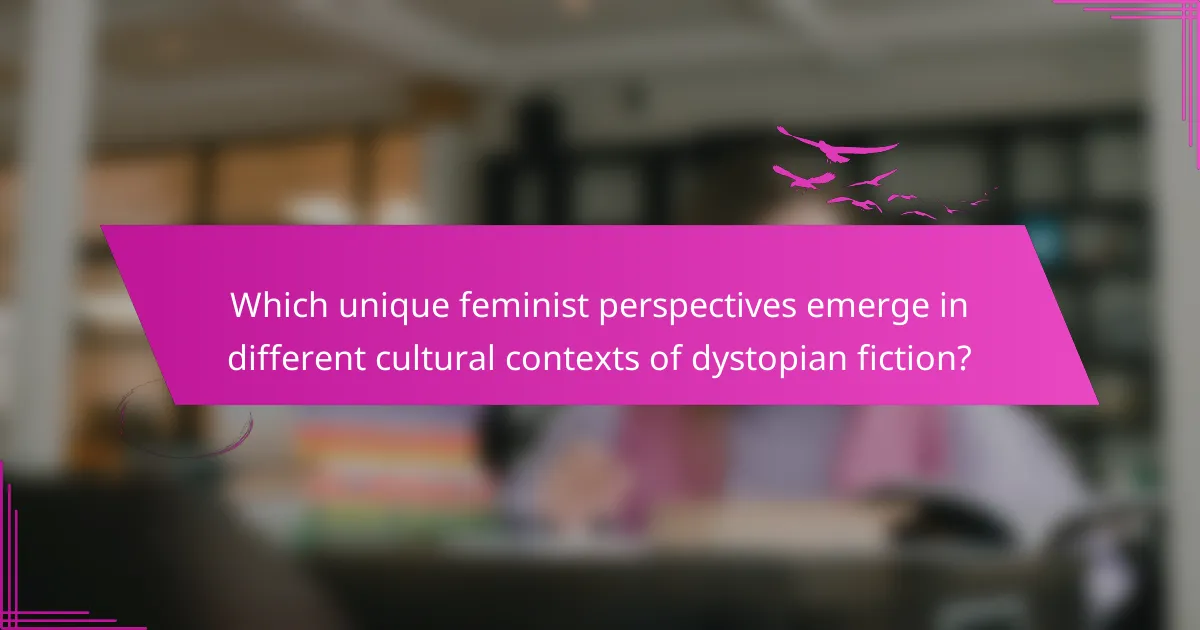
Which unique feminist perspectives emerge in different cultural contexts of dystopian fiction?
Unique feminist perspectives in dystopian fiction vary across cultural contexts, highlighting diverse gender roles and resistance strategies. In Western narratives, themes often focus on individual empowerment and systemic critique. In contrast, non-Western works may emphasize community solidarity and cultural preservation.
For instance, Margaret Atwood’s “The Handmaid’s Tale” critiques patriarchal structures through individual rebellion. Meanwhile, Nnedi Okorafor’s “Binti” showcases a protagonist who navigates cultural identity and gender within a sci-fi framework.
These narratives reflect unique attributes of feminism shaped by their cultural backgrounds, illustrating how resistance manifests differently. As a result, dystopian fiction serves as a lens to explore the intersection of gender and culture, revealing the complexities of feminist thought.
How do regional variations influence feminist themes in dystopian literature?
Regional variations significantly shape feminist themes in dystopian literature by reflecting diverse cultural contexts. Different societal norms influence how gender roles are portrayed and resisted. For instance, in Western dystopias, themes often critique patriarchal structures, while non-Western narratives may focus on colonialism’s impact on women’s rights. This variation highlights unique attributes of feminist resistance across cultures, showcasing how local histories inform the struggle against oppression. As a result, regional settings enrich the genre, providing a broader understanding of feminism’s complexities within dystopian frameworks.
What are the rare narratives that challenge mainstream feminist portrayals?
Rare narratives in dystopian fiction often present feminist portrayals that diverge from mainstream perspectives. These narratives challenge traditional gender roles by depicting women in complex, multifaceted roles, often as leaders, strategists, or rebels. For example, in works like “The Power” by Naomi Alderman, women gain physical dominance, flipping societal norms. Another instance is “Parable of the Sower” by Octavia Butler, where a female protagonist navigates a chaotic world, emphasizing resilience and adaptability. These stories highlight unique attributes of female empowerment and agency, showcasing resistance against oppressive systems while offering nuanced views on gender dynamics.
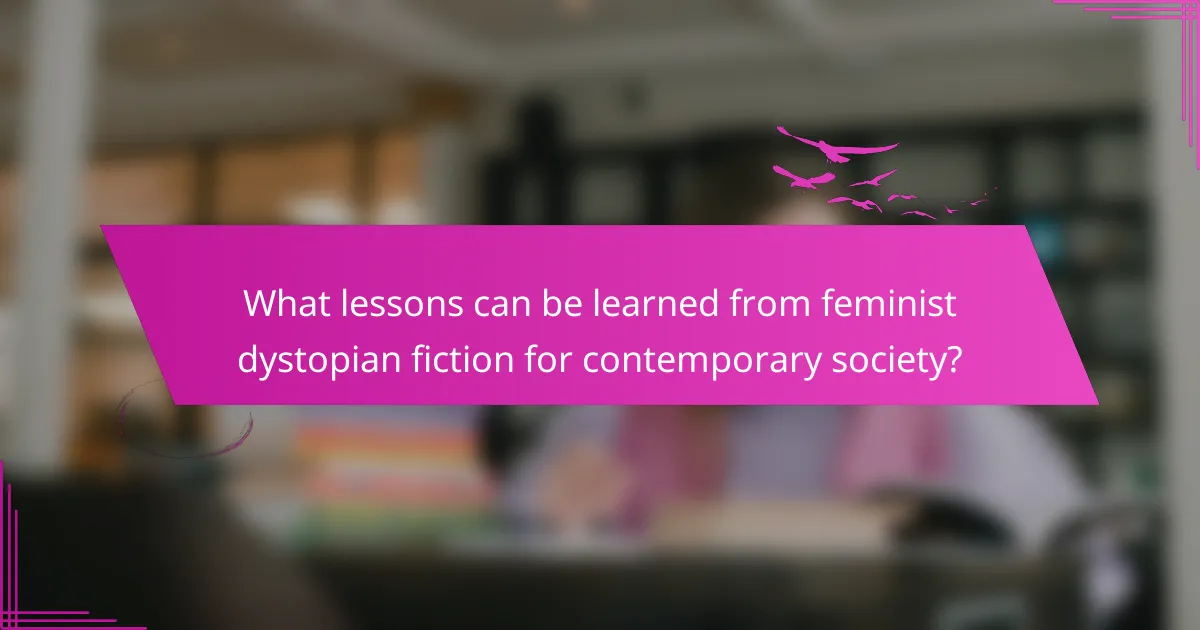
What lessons can be learned from feminist dystopian fiction for contemporary society?
Feminist dystopian fiction teaches valuable lessons about gender roles and resistance that are relevant today. These narratives highlight the consequences of patriarchal control, emphasizing the need for vigilance against oppression. They encourage critical examination of societal norms and inspire activism for gender equality. Characters often embody resilience, showcasing diverse forms of resistance that can motivate contemporary movements. Furthermore, these stories reveal the importance of solidarity among marginalized groups, illustrating how collective action can challenge systemic injustices.
How can readers apply feminist insights from dystopian narratives to real-world issues?
Readers can apply feminist insights from dystopian narratives to real-world issues by recognizing and challenging gender roles. Dystopian fiction often highlights systemic oppression and resistance, offering frameworks for understanding contemporary gender inequalities. For instance, characters in these narratives frequently embody resilience, inspiring activism against patriarchal structures. By analyzing these stories, readers can identify parallels in society, fostering critical discussions about gender justice. Such insights encourage individuals to advocate for equality, utilizing lessons from fiction to inform real-life actions and policies.
What best practices can be drawn from the representation of women in dystopian fiction?
Dystopian fiction often illustrates women’s resilience and challenges traditional gender roles. These narratives highlight the strength of female characters as they resist oppressive systems.
Common best practices include portraying diverse female experiences to avoid stereotypes. Authors should emphasize women’s agency, showcasing their roles as leaders and decision-makers. Additionally, integrating intersectionality can deepen representation, reflecting varied backgrounds and struggles.
Feminist themes often emerge through solidarity among women. Stories that emphasize collaboration can inspire readers and challenge patriarchal structures. Highlighting female friendships and alliances can serve as a powerful counter-narrative to isolation and competition.
Lastly, using speculative elements can critique contemporary issues. By envisioning future societies, authors can explore the implications of current gender dynamics, prompting readers to reflect on real-world inequalities.
